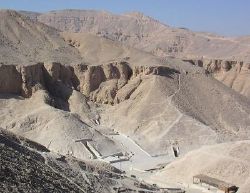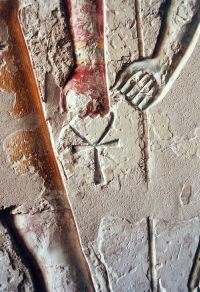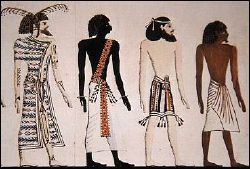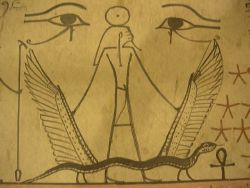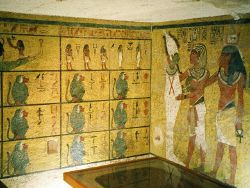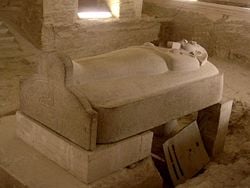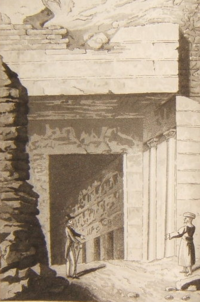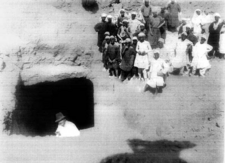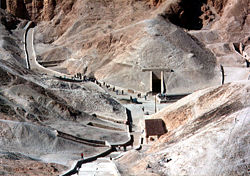Valley of the Kings
The Valley of the Kings (Arabic: وادي الملوك Wadi Biban el-Muluk; "Gates of the King") is a valley in Egypt where for a period of nearly 500 years from the sixteenth to eleventh century B.C.E., tombs were constructed for the Pharaohs and powerful nobles of Ancient Egypt. It stands on the west bank of the Nile, across from Thebes, and consists of two valleys, East Valley (where the majority of the royal tombs situated) and West Valley.
The area has been a focus of concentrated archaeological and egyptological exploration since the end of the eighteenth century, and its tombs and burials continue to stimulate research and interest. In modern times the valley has become famous for the discovery of the tomb of Tutankhamun, (which is widely known both for its incredible collection of beautiful artifacts and for its alleged "curse of the pharaohs") and is one of the most famous archaeological sites in the world. In 1979, along with the rest of the Theban Necropolis, it became a World Heritage Site.[1]
The continued efforts of archaeologists to uncover these tombs, careful of both the construction of the tombs, their decorations, and their artifacts, has allowed modern humankind an amazing insight and opportunity to experience the lives of the highly influential and important civilization of Ancient Egypt. Preservation of the area and the artifacts, and the making of them available to public display, has greatly enhanced our understanding of human history, drawing all humankind closer together in mutual respect and warmth of feeling, breaking down the barriers of time and reuniting the human family.
Geology
The Theban hills in which the valley is located are an alternating sandwich of dense limestone and other sedimentary rock (which form the cliffs in the valley and the nearby Deir el-Bahri) and soft layers of marl. The sedimentary rock was originally deposited between 35 - 56 million years ago during a time when the precursor to the Mediterranean Sea covered an area that extended much further inland than today. During the Pleistocene the valley was carved out the plateau by steady rains.[2] There is currently little year-round rain in this part of Egypt, but there are occasional flash floods which hit the valley, dumping tons of debris into the open tombs.[3]
The quality of the rock in the Valley is inconsistent, ranging from finely-grained to coarse stone, the latter with the potential to be structurally unsound. The occasional layer of shale also caused construction and conservation difficulties, as this rock expands in the presence of water, forcing apart the stone surrounding it. It is thought that some tombs were altered in shape and size depending on the types of the layers of rock the builders encountered.[2]
Builders took advantage of available geological features when constructing the tombs. Some tombs were quarried out of existing limestone clefts, others behind slopes of scree, or were at the edge of rock spurs created by ancient flood channels.[2]
The problems of tomb construction can be seen with tombs of Ramesses III and his father Setnakhte. Setnakhte started to excavate KV11, but broke into the tomb of Amenmesse, so construction was abandoned and he instead usurped the tomb of Twosret, KV14. When looking for a tomb, Ramesses III extended the part-excavated tomb started by his father.[4] The tomb of Ramesses II returned to an early style, probably due to the quality of the rock being excavated.
Between 1998-2002 the Amarna Royal Tombs Project investigated the valley floor using ground-penetrating radar and found that below the modern surface the Valley's cliffs descend beneath the scree in a series of abrupt, natural "shelves," arranged one below the other, descending several meters down to the bedrock in the valley floor.[5]
History
The Valley of the Kings (Wadi Biban el-Muluk – وادي الملوك – Gates of the King in Arabic)[6] is a valley in Egypt where for a period of nearly 500 years for the sixteenth to eleventh century B.C.E., tombs were constructed for the kings and powerful nobles of the New Kingdom (the Eighteenth through Twentieth Dynasties of Ancient Egypt).[7][8]
The valley stands on the west bank of the Nile, across from Thebes (modern Luxor), within the heart of the Theban Necropolis.[9] The wadi consists of two valleys, East Valley (where the majority of the royal tombs situated) and West Valley.
The Theban Hills are dominated by the peak of al-Qurn, known to the Ancient Egyptians as ta dehent, or 'The Peak'.[10] It has a pyramid shaped appearance, and it is considered to have been the reason why the kings of Egypt started to be buried beneath it, echoing the pyramids of the Old Kingdom, more than a thousand years prior to the first royal burials carved out in the Valley of the Kings.[11][12] Its isolated position also resulted in reduced access, and special tomb police (the Medjay) were able to guard the necropolis.
While the iconic pyramid complexes of the Giza plateau have come to symbolize ancient Egypt, the majority of tombs were in fact cut into rock. Most pyramids and mastabas contain sections which are cut into ground level, and there are full rock-cut tombs in Egypt that date back to the Old Kingdom.
After the defeat of the Hyksos and the reunification of Egypt under Ahmose I, the Theban rulers began to construct elaborate tombs that would reflect their new found power.[13] The tombs of Ahmose and his son Amenhotep I were probably (their exact location remains unknown) in the Seventeenth Dynasty necropolis of Dra' Abu el-Naga'.[14] The first royal tomb in the valley were those of Amenhotep I (although this identification is also disputed),[15] and Thutmose I, whose advisor Ineni notes in his tomb that he advised his king to place his tomb in the desolate valley (the identity of this actual tomb is unclear, but it is probably KV20 or KV38).[10]
"I saw to the excavation of the rock-tomb of his majesty, alone, no one seeing, no one hearing."[16]
One of the most famous leaders in world history was King Tutankhamun. Most of his modern popularity stems from the fact that his tomb in the Valley of the Kings was discovered almost completely intact. However, he is also significant as a figure who managed the beginning of the transition from the heretical Atenism of his predecessors Akhenaten and Smenkhkare back to the familiar Egyptian religion. There is great speculation on Tutankhamun's death, and the alleged "curse of the pharaohs" associated with his tomb.[17] Many archaeologists, scientists, Egyptian experts and Egyptologists have come up and debated on the mysterious king Tut's death with their own hypotheses with historical and archaeological evidences. They are still questioning each other how he died, whether by natural or sinister means. Some suggest a brain tumor, or a blow to the back of the head as he slept, which would be indicated by the lump on the back of his cranium. Others claim conspiracy involving his wife. As a point of note, a number of strange and bizarre accidents have been associated with his tomb since its discovery.
The Valley was used for primary ritualistic burials from approximately 1539 B.C.E. to 1075 B.C.E., and contains at least 63 tombs, beginning with Thutmose I (or possibly earlier, during the reign of Amenhotep I), and ending with Ramesses X or XI. Despite the name, the Valley of the Kings also contains the tombs of favorite nobles as well as the wives and children of both nobles and pharaohs. Around the time of Ramesses I (ca. 1301 B.C.E.) construction commenced in the separate Valley of the Queens, although some wives continued to be buried with their husbands in the Valley of the Kings.
Royal Necropolis
The official name for the site in ancient times was The Great and Majestic Necropolis of the Millions of Years of the Pharaoh, Life, Strength, Health in The West of Thebes, or more usually, Ta-sekhet-ma'at (the Great Field).[18]
| |
At the start of the Eighteenth Dynasty, only the kings were buried within the valley in large tombs, when a non-royal was buried, it was in a small rock cut chamber, close to the tomb of their master.[16] Amenhotep III's tomb was constructed in the Western Valley, and while his son Akhenaten moved his tomb's construction to Amarna, it is thought that the unfinished WV25 may have originally been intended for him.[19] With the return to religious orthodoxy at the end of the Eighteenth Dynasty, Tutankhamun, Ay and then Horemheb returned to the royal necropolis.
The Nineteenth and Twentieth Dynasties saw an increase in the number of burials (both here and in the Valley of the Queens), with Ramesses II and later Ramesses III constructing a massive tomb that was used for the burial of his sons (KV55 and KV3 respectively). There are some kings that are not buried within the valley or whose tomb has not been located, Thutmose II may have been buried in Dra' Abu el-Naga' (although his mummy was in the Deir el-Bahri tomb cache), Smenkhkare's burial has never been located, and Ramesses VIII seems to have been buried elsewhere.
- Deir el-Medina
The tombs were constructed and decorated by the workers of the village of Deir el-Medina, located in a small wadi between this valley and the Valley of the Queens, facing Thebes. The workers journeyed to the tombs via routes over the Theban hills. The daily lives of these workers are quite well known, recorded in tombs and official documents.[20]
- Mortuary Temples
In the Pyramid Age the tomb of the king was associated with a mortuary temple located close to the pyramid. As the tomb of the king was hidden, this mortuary temple was located away from the burial, closer to the cultivation facing towards Thebes.
Tomb development
- Location
The earliest tombs were location into cliffs at the top of scree slopes, under storm-fed waterfalls (for example KV34 and KV43).[10] As these locations were soon used, burials then descended to the valley floor, gradually moving back up the slopes as the valley bottom filled up with debris. This explains the location of the tombs KV62 and KV63 buried in the valley floor.
- Architecture
The usual tomb plan of a long inclined rock-cut corridor, descending through one or more halls (possibly mirroring the descending path of the sun-god into the underworld,[21]) to the burial chamber. In the earlier tombs the corridors turn through 90 degrees at least once (such as KV43, the tomb of Thutmose IV), and the earliest had cartouche-shaped burial chambers (KV43, the tomb of Thutmose IV). This layout is known as 'Bent Axis',[22] and after the burial the upper corridors were meant to be filled with rubble, and the entrance to the tomb hidden.[23] After the Amarna period, the layout gradually straightened, with an intermediate 'Jogged Axis' (the tomb of Horemheb, KV57 is typical of this, and is one of the tombs that is sometimes open to the public), to the generally 'Straight Axis' of the late Nineteenth and Twentieth Dynasty tombs (Ramesses III's and Ramesses IX's tombs, KV11 and KV6 respectively).[24] As the the tomb's axes straightened, the slope also lessened, and almost disappeared in the late Twentieth Dynasty.[25] Another feature that is common to most tombs is the 'well', which may have originated as an actual barrier intended to stop flood waters entering the lower parts of the tombs. It later seems to have developed a 'magical' purpose as a symbolical shaft. In the later Twentieth Dynasty, the well itself was sometimes not excavated, but the well room was still present.
- Decoration
The majority of the royal tombs were decorated with religious texts and images. The early tombs were decorated with scenes from Amduat ('That Which is in the Underworld'), with describes the journey of the sun-god through the twelve hours of the night. From the time of Horemheb, tombs were decorated with the Book of Gates, which shows the sun-god passing through the twelve gates that divide the night time, and ensure the tomb owner's own safe passage through the night.
Late in the Nineteenth Dynasty the Book of Caverns, which divided the underworld into massive caverns containing deities and the deceased waiting for the sun to pass through and restore them to life. The burial of Ramesses III saw the Book of the Earth, where the underworld is divided into 4 sections, climaxing in the sun disc being pulled from the earth by Naunet.
The ceilings of the burial chambers were decorated (from the burial of Seti I onwards) with what become formalised as the Book of the Heavens, which again describe the sun's journey through the twelve hours of night. Again from Seti I's time, the Litany of Re, a lengthy hymn to the sun god.
- Tomb equipment
Each burial was provided with equipment that would enable them a continued existence in the afterlife in comfort. Also present in the tombs were ritual magical items, such as Shabti's and divine figurines. Some equipment was that which the king may have used in their lifetime (Tutankhamun's sandles for example), and some was specially constructed for the burial.
- Tomb numbering
The modern abbreviation "KV" stands for "Kings' Valley," and the tombs are numbered in the order of 'discovery' from Ramesses VII (KV1) to KV63 (which was discovered in 2005), although many of the tombs have been open since antiquity, and KV5 was only rediscovered in the 1990s (after being dismissed as unimportant by previous investigators).[26] The West Valley tombs often have the "WV" prefix, but follow the same numbering system. A number of the tombs are unoccupied, the owners of others remain unknown, and others are merely pits used for storage.[27] Most of the open tombs in the Valley of the Kings are located in the East Valley, and this is where most tourists and facilities can be found.
Eighteenth Dynasty
The Eighteenth dynasty tombs within the valley vary a good deal in decoration, style and location. At first there seems to have been no fixed plan, indeed the tomb of Hatshepsut is of a unique shape, twisting and turning down over 200 metres from the entrance so that the burial chamber is 97 metres below the surface. The tombs gradually became more regular and formalized, and the tomb's of Thutmose III and Thutmose IV, KV34 and KV43 are good examples of Eighteenth Dynasty tombs, both with their bent axis, and simple decoration.
Perhaps the most imposing tomb of this period is that of Amenhotep III, WV22 located in the West Valley. It was re–investigated in 1990s (by a team from Waseda University, Japan), but is not open to the public.[28]
At the same time, powerful and influential nobles started to be buried with the royal family, the most famous of these tombs is the joint tomb of Yuya and Tjuyu, KV46. They were possibly the parents of Queen Tiy, and until the discovery of the tomb of Tutankhamun, this was the best preserved tomb to be found in the Valley.
Amarna Period
The return of royal burials to Thebes after the end of Amarna period marks a change to the layout of royal burials, with the intermediate 'jogged axis' gradually giving way to the 'straight axis' of later dynasties. In the Western valley, there is a tomb commencement that is thought to have been started for Akhenaten, but is no more than a gateway and a series of steps. Close by to this tomb is the tomb of Ay, Tutankhamun's successor. It is likely that this tomb was started for Tutankhamun (its decoration is of a similar style), but later usurped for Ay's burial (this would mean that KV62 may have been Ay's original tomb, which would explain the smaller size and unusual layout for a royal tomb).
The other Amarna period tombs are located in a smaller, central area in the centre of the East Valley, with a possible mummy cache (KV55) that possibly contains the possible burials of several Amarna Period royals – Tiy and Smenkhkare or Akhenaten.[29]
Close to this is the burial of Tutankhamun, perhaps the most famous discovery of modern Western archaeology and was made here by Howard Carter on November 4, 1922, with clearance and conservation work continuing until 1932. This was the first royal tomb to be discovered that was still largely intact (although tomb robbers had entered it), and was, until the excavation of KV63 on March 10, 2005.[30], considered the last major discovery in the valley. The opulence of his grave goods notwithstanding, Tutankhamun was a rather minor king and other burials probably had more numerous treasures.
In the same central area as KV62 and KV63, is 'KV64' a radar anomaly believed to be a tomb or chamber announced on 28 July 2006. It is not an official designation, and indeed the actual existence of a tomb at all is dismissed by the Supreme Council of Antiquities.[31]
The nearby tomb of Horemheb, (KV57) is rarely open for visitors, but it is superbly decorated and has excellent tomb paintings.
Nineteenth Dynasty
The nineteenth dynasty saw a further standardization of tomb layout and decoration. The tomb of the first king of the dynasty Ramesses I was hurriedly finished (due to the death of the king), and is little more than a descending corridor and a burial chamber, however KV16 has vibrant decoration, and still contains the sarcophagus of the king. Its central location means that it is one of the frequently visited tombs. It shows the development of the tomb entrance and passage and of decoration.
His son and successor, Seti I's tomb, KV17 (also known as Belzoni's tomb, the tomb of Apis, or the tomb of Psammis, son of Necho) is usually thought to be the finest tomb in the valley, with well executed relief work and paintings.
The son of Seti, Ramesses the Great constructed a massive tomb, KV7, but it is in a ruinous state. It has undergone excavation and conservation by a Franco-Egyptian team led by Christian Leblanc.[32] It is a vast size, being about the same length, and a larger area, of the tomb of his father. Its layout returns to the earlier 'bent axis', maybe due to the poor quality of the rock found during excavation.
At the same time (and just opposite his own tomb), Ramesses enlarged the earlier small tomb of an unknown Eighteenth Dynasty noble (KV5) for his numerous sons. With 120 known rooms and excavation work still underway, it is probably the largest tomb in the valley. Originally opened (and robbed) in antiquity it is a low-lying structure that has been particularly prone to the flash floods that sometimes hit the area, which washed in tones of debris and material over the centuries, ultimately concealing its vast size. It is not currently open to the public.[33]
Ramesses II's son and eventual successor, Merenptah's tomb has been open since antiquity, it extends 160 metres, ending in a burial chamber that once contained a set of four nested sarcophagi.[34] Well decorated, it is typically open to the public most years.
The last kings of the dynasty also constructed tombs in the valley, all of which follow the same general pattern of layout and decoration, notable amongst these is the tomb of Siptah, which is well decorated, especially the ceiling decoration.[35]
Twentieth Dynasty
The first ruler of the dynasty, Setnakhte actually had two tombs constructed for himself, he started to excavate the eventual tomb of his son, Ramesses III but broke into another tomb, and abandoned it in order to usurp and complete the tomb of the Nineteenth dynasty female pharaoh Twosret. This tomb therefore has two burial chambers, the later extensions making the tomb one of the largest of the Royal tombs, at over 112 meters.
The tomb of Ramesses III (known Bruce's Tomb, The Harper's Tomb) is one of the largest tombs in the valley, and is open to the public, it is located close to the central 'rest–area', and is location and superb decoration usually makes this one of the tombs visited by tourists.[36]
The successors and offspring of Ramesses III constructed tombs that had straight axes, and were decorated in much the same manner as each other, notable amongst these are KV2, the tomb of Ramesses IV, which has been open since antiquity, containing a large amount of hieratic graffiti. The tomb is mostly intact and is decorated with scenes from several religious texts.[37] The joint tomb of Ramesses V and Ramesses VI, KV9 (also known as the Tomb of Memnon or La Tombe de la Métempsychose) is decorated with many sunk-relief carvings, depicting many illustrated scenes from religious texts. Open since antiquity, it contains over a thousand graffiti in ancient Greek, Latin and Coptic.[38] The spoil from the excavation and later clearance of this tomb covered the earlier burial of KV62 and seems to have been what protected that tomb from earlier discovery and looting.
The tomb of Ramesses IX, KV6 has been open since antiquity, as can be seen by the graffiti left on its walls by Roman and Coptic visitors.[39] Located in the central part of the Valley, it stands between and slightly above KV5 and KV55. The tomb extends a total distance of 105 metres into the hillside, including extensive side chambers which were neither decorated nor finished. The hasty and incomplete nature of the rock-cutting and decorations within the tomb indicate that that the tomb was not completed by the time of Ramesses' death.
Another notable tomb from this dynasty is KV19 the tomb of Mentuherkhepshef (son of Ramesses IX). The tomb is small and is really just a converted, unfinished corridor, but the decoration is superb and the tomb has been newly restored and open for visitors.
Twenty-first Dynasty and the decline of the necropolis
By the end of the New Kingdom, Egypt had entered a long period of political and economic decline. The priests at Thebes grew in power and effectively administered Upper Egypt, while kings ruling from Tanis controlled Lower Egypt. Some attempt at using the open tombs was made at the start of the Twenty first Dynasty, with the High Priest of Amun Pinedjem I adding his cartouche to KV4.[40] The Valley began to be heavily plundered, so during the 21st Dynasty the priests of Amen opened most of the tombs and moved the mummies into three tombs in order to better protect them, even removing most of their treasure in order to further protect the bodies from robbers. Later most of these were moved to a single cache near Deir el-Bari (known as TT320), located in the cliffs overlooking Hatshepsut's famous temple, this mass reburial contained an astounding number of royal mummies. They were found in a great state of disorder, many placed in other's coffins, and several are still unidentified. Other mummies were moved to the tomb of Amenhotep II, where over a dozen mummies, many of them royal, were later relocated.[41]
During the later Third Intermediate Period and later periods, intrusive burials were introduced into many of the open tombs. In Coptic times, some of the tombs were used as churches, stables and even houses.
Exploration of the Valley
The Valley of the Kings has been a major area of modern Egyptological exploration for the last two centuries. Before this the area was a site for tourism in antiquity (especially during Roman times). This area illustrates the changes in the study of ancient Egypt, starting as antiquity hunting, and ending as scientific excavation of the whole Theban Necropolis. Despite the exploration and investigation noted below, only eleven of the tombs have actually been completely recorded.
The Greek writers Strabo (1st century B.C.E.) and Diodorus Siculus (1st century C.E.) were able to report that the total number of Theban royal tombs was 47, of which at the time only 17 were believed to be undestroyed.[42] Pausanias and other ancient writers remarked on the pipe-like corridors of the Valley, clearly meaning the tombs.
Clearly others also visited the valley in these times, as many of the tombs have graffiti written by these ancient tourists. Jules Baillet located over 2100 Greek and Latin graffiti, along with a smaller number in Phoenician, Cypriot, Lycian, Coptic, and other languages.[43] The majority of the ancient graffiti are found in KV9, containing just under a thousand of them. The earliest positively dated graffiti dates to 278 B.C.E.[42]
Tomb Raiders
Almost all of the tombs have been ransacked, including Tutankhamun's, though in its case, it seems that the robbers were interrupted, so very little was removed.[44] Several papyrus have been found that describe the trials of tomb robbers, these date mostly from the late Twentieth Dynasty. One of these (Papyrus Mayer B) describes the robbery of the tomb of Ramesses VI and was probably written in Year 9 of Ramesses IX:
The foreigner Nesamun took us up and showed us the tomb of King Ramesses VI …. And I spent four days breaking into it, we being present all five. We opened the tomb and entered it. … We found a cauldron of bronze, three wash bowls of bronze …[45]
The valley also seems to have suffered an official plundering during the virtual civil war which started in the reign of Ramesses XI. The tombs were opened, all the valuables removed, and the mummies collected into two large caches. One in the tomb of Amenhotep II, contained sixteen, and others were hidden within Amenhotep I's tomb. A few years later most of them were moved to the so-called Deir el-Bahri cache, contained no less than 40 royal mummies and their coffins.[46] Only those tombs whose locations were lost (KV62, KV63 and KV46) were undisturbed in this period.
Eighteenth century
Before the nineteenth century, travel from Europe to Thebes (and indeed anywhere in Egypt) was difficult, time-consuming and expensive, and only the hardiest of European travelers visited – before the travels of Father Claude Sicard in 1726, it was unclear just where Thebes really was.[47] It was known to be on the Nile, but it was often confused with Memphis and several other sites. One of the first travelers to record what he saw at Thebes was Frederic Louis Norden, a Danish adventurer and artist.
He was followed by Richard Pococke, who published the first modern map of the valley itself, in 1743.
- French Expedition
In 1799, Napoleon's expedition (especially Dominique Vivant) drew maps and plans of the known tombs, and for the first time noted the Western Valley (where Prosper Jollois and Édouard de Villiers du Terrage located the tomb of Amenhotep III, WV22).[48] The Description de l'Égypte contains two volumes (out a total of 24) on the area around Thebes.
Nineteenth century
European exploration continued in the area around Thebes during the nineteenth century, boosted by Jean-François Champollion's translation of hieroglyphs early in the century. Early in the century, the area was visited by Belzoni, working for Henry Salt, who discovered several tombs, including those of Ay in the West Valley (WV23) in 1816 and Seti I (KV17) the next year. At the end of his visits, Belzoni declared that all of the tombs had been found and nothing of note remained to be found. Working at the same time (and a great rival of Belzoni and Salt) was Bernardino Drovetti, the French Consul-General.
In 1827 John Gardiner Wilkinson was assigned to paint the entry of every tomb, giving them each a designation that is still in use today – they were numbered from KV1 to KV21 (although the maps show 28 entrances, some of which were unexplored). These paintings and maps were later published in The Topography of Thebes and General Survey of Egypt, in 1830. At the same time James Burton explored the valley. His works included making KV17 safer from flooding, but he is better known for entering KV5.
Champollion himself visited the valley, along with Ippolito Rosellini and Nestor L'Hôte, in the Franco-Tuscan Expedition of 1829. The expedition spent two months studying the open tombs, visiting about 16 of them. They copied the inscriptions and identified the original tomb owners. In tomb KV17, they removed wall decorations, which are now on display in the Louvre in Paris.
In 1845 – 1846 the valley was explored by Karl Richard Lepsius's expedition, they explored and documented 25 in the main valley and four in the west.
The latter half of the century saw a more concerted effort to preserve rather than simply gathering antiquities. Auguste Mariette's Egyptian Antiquities Service started to explore the valley, first with Eugène Lefébure in 1883,[49] then Jules Baillet and Georges Bénédite in early 1888 and finally Victor Loret in 1898 to 1899. During this time Georges Daressy explored KV9 and KV6.
Loret added a further 16 tombs to the list, and explored several tombs that had already been discovered.
When Gaston Maspero was reappointed to head the Egyptian Antiquities Service, the nature of the exploration of the valley changed again, Maspero appointed Howard Carter as the Chief Inspector of Upper Egypt and the young man discovered several new tombs and explored several others, clearing KV42 and KV20.
Twentieth century
Around the turn of the twentieth century, the American Theodore M. Davis had the excavation permit in the valley, and his team (led mostly by Edward R. Ayrton) discovered several royal and non-royal tombs (KV43, KV46 & KV57 being the most important). In 1907 they discovered the possible Amarna Period cache in KV55. After finding what they thought was the burial of Tutankhamun (KV61), it was announced that the valley was completely explored and no further burials were to be found.
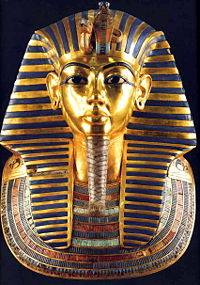
Howard Carter then acquired the right to explore the valley and after a systematic search discovered the actual tomb of Tutankhamun (KV62) in November 1922.
At the end of the century, the Theban Mapping Project re-discovered and explored tomb KV5, which has since been discovered to be probably the largest in the valley (having at least 120 rooms), and was either a cenotaph or real burial for the sons of Ramesses II. Elsewhere in the eastern and western branches of the valley several other expeditions cleared and studied other tombs. Until 2002 the Amarna Royal Tombs Project has been exploring the area around KV55 and KV62, the Amarna Period tombs in the main valley.
Twenty-first century
Various expeditions have continued to explore the valley, adding greatly to the knowledge of the area. In 2001 the Theban Mapping Project designed new signs for the tombs, providing information and plans of the open tombs.
On February 8, 2006, the Supreme Council of Antiquities announced that an American team led by the University of Memphis had uncovered a pharaonic-era tomb (KV63), the first uncovered there since King Tutankhamun's in 1922. The 18th Dynasty tomb included five mummies in intact sarcophagi with coloured funerary masks along with more than 20 large storage jars, sealed with pharaonic seals. It is located close to the tomb of Tutankhamun. KV63, as it is known, appears to be a single chamber with five or six sarcophagi and about 20 large funerary jars. The chamber is from the 18th dynasty and it appears to have been a deposit of funerary preparation materials, rather than a tomb.
On July 31, 2006, Nicholas Reeves announced that analysis of ground penetrating radar for the autumn of 2000 showed a sub-surface anomaly in the area of KV62 and KV63. He has tentatively labeled this anomaly "KV64".[50] This has caused some controversy, as only Egypt's Supreme Council of Antiquities can officially designate the name of a new tomb, the anomaly may not in fact be a tomb, and because Reeves had reported the finding to the press first, instead of a scientific paper.[31]
Tourism
Most of the tombs are not open to the public (16 of the tombs can be opened, but they are rarely open at the same time), and officials occasionally close those that are open for restoration work. The number of visitors to KV62 has led to a separate charge for entry into the tomb. The West Valley has only one open tomb – that of Ay – and a separate ticket is needed to visit this tomb. The tour guides are no longer allowed to lecture inside the tombs and visitors are expected to proceed quietly and in single file through the tombs. This is to minimize time in the tombs, and prevent the crowds from damaging the surfaces of the decoration. Photography is no longer allowed in the tombs.
In 1997, 58 tourists and 4 Egyptians were massacred at nearby Deir el-Bahri by Islamist militants from Al-Gama'a al-Islamiyya. This led to an overall drop in tourism in the area.[51]
In January 2006 it was announced that a new visitors center was to be constructed on the old cafeteria.[52] The air-conditioned center has displays and exhibits (including a model of the valley), showing the chronology and iconography of the New Kingdom necropolis, a movie about Carter’s discovery of the tomb of Tutankhamun.[53]
Notes
- ↑ Ancient Thebes with its necropolis. UNESCO Work Heritage Sites. Retrieved January 15, 2016.
- ↑ 2.0 2.1 2.2 Geography and Geology of the Valley.. Theban Mapping Project. Retrieved January 15, 2016.
- ↑ Bonnie M. Sampsell, A Traveller's Guide to the Geology of Egypt (Cairo: American University Press, 2003), 78.
- ↑ Arthur Weigall, A Guide to the Antiquities of Upper Egypt (Kessinger, 2006), 194.
- ↑ Amarna Royal Tombs Project. Retrieved January 15, 2016.
- ↑ Nicholas Reeves and Richard H. Wilkinson, The Complete Valley of the Kings (Thames and Hudson, 1996), 6.
- ↑ Gaston Maspero, Manual of Egyptian Archaeology, (IndyPublish.com, 2005, ISBN 1421941694), 182.
- ↑ Theban Mapping Project Retrieved January 15, 2016.
- ↑ Alberto Siliotti, Guide to the Valley of the Kings (Barnes and Noble, 1997), 13.
- ↑ 10.0 10.1 10.2 Historical Development of the Valley of the Kings in the New Kingdom Theban Mapping Project. Retrieved January 15, 2016.
- ↑ Aidan Dodson, Egyptian Rock-cut Tombs (Buckinghamshire: Shire Publications Ltd., 1991), 5-7.
- ↑ Reeves and Wilkinson, (1996), 17
- ↑ John Baines and Jaromir Malik, Cultural Atlas of Ancient Egypt (Checkmark Books, 2000), 99.
- ↑ Nigel Strudwick and Helen Strudwick, Thebes in Egypt (Ithaca, NY: Cornell University, 1999), 94.
- ↑ Reeves and Wilkinson (1996), 89.
- ↑ 16.0 16.1 Weigall (1910), 186.
- ↑ Brian Handwerk, Egypt's "King Tut Curse" Caused by Tomb Toxins? National Geographic, May 6, 2005. Retrieved January 15, 2016.
- ↑ 18.0 18.1 Siliotti (1997), 12-13.
- ↑ Reeves and Wilkinson (1996), 116.
- ↑ The Deir el-Medina Database Introduction to the Deir el-Medina Database. Leiden University. Retrieved January 15, 2016.
- ↑ Strudwick and Strudwick (1999), 117.
- ↑ Wilkinson (1993), 10-20.
- ↑ Strudwick and Strudwick (1999), 98.
- ↑ Reeves and Wilkinson (1996), 25.
- ↑ Corinna Rossi, "Dimensions and Slope in the the Nineteenth and Twentieth Dynasty Royal Tombs" The Journal of Egyptian Archaeology 87(2001): 73-80: 75. ISSN: 0307-5133.
- ↑ Weigall (1910), 198.
- ↑ Donald P. Ryan, Further Observations Concerning the Valley of the Kings. Valley of the Sun Kings: New Explorations in the Tombs of the Pharaohs. (Pacific Lutheran University, 1995). Retrieved January 15, 2016.
- ↑ INTERIM REPORT ON THE RE-CLEARANCE AT THE ROYAL TOMB OF AMENOPHIS III. Research in Egypt 1966-1991. (Institute of Egyptology at Waseda University, 1991) Retrieved January 15, 2016.
- ↑ Theodore M. Davis, The Tomb of Siphtah with The Tomb of Queen Tiyi (London: Gerald Duckworth & Co Ltd.,. 2001), XV.
- ↑ MSNBC Egypt offers first look at newly discovered tomb: First such discovery in Valley of the Kings since Tutankhamun’s in 1922. 2006-02-10. Retrieved January 15, 2016.
- ↑ 31.0 31.1 Dan Vergano, Egyptian tomb digs up controversy. USA Today August 14, 2006. Retrieved July 20, 2007.
- ↑ Recherches et travaux dans la tombe de Ramses II: Aujourďhui Recherches et Travaux Tombe Ramses (L'Institut d'Egyptologie Thébaine du Musée du Louvre) Retrieved January 15, 2016. (in French)
- ↑ Kent R. Weeks (2000). KV 5: A Preliminary Report on the Excavation of the Tomb of the Sons of Ramesses II in the Valley of the Kings. (Cairo: American University Press)
- ↑ Weigall (1910), 202.
- ↑ Davis (2001), 1.
- ↑ Weigall (1910), 206.
- ↑ Weigall (1910), 196.
- ↑ KV 9 (Rameses V and Rameses VI). Theban Mapping project Retrieved January 15, 2016.
- ↑ Weigall (1910), 198.
- ↑ Reeves and Wilkinson (1996), 208.
- ↑ Weigall (1910), 221.
- ↑ 42.0 42.1 Reeves and Wilkinson (1996), 51.
- ↑ Jules Baillet, Inscriptions grecques et latines des tombeaux des rois ou Syringes à Thèbes (Cairo: Institut Français d'Archéologie Orientale du Caire, Mémoires publiés par les membres, 1920-1926). (in French)
- ↑ Valley of the Kings, finds in the Petrie Museum UCL Digital Egypt. Retrieved January 15, 2016.
- ↑ Reeves and Wilkinson (1996), 192.
- ↑ Weigall (1910), 191.
- ↑ Egyptian Civilization & Mythology course, Discovers of Ancient Egypt. University of Wisconsin–Milwaukee. Retrieved January 15, 2016.
- ↑ Siliotti (1997), 16.
- ↑ Project Amenmesse Homepage. Amenmesse Project. Retrieved January 15, 2016.
- ↑ Nicholas Reeves interview: Another New Tomb in the Valley of the Kings?. Archaeology Magazine. August 3, 2006. Retrieved January 15, 2016.
- ↑ Tourists massacred at temple. BBC News, November 17, 1997. Retrieved January 15, 2016.
- ↑ August 2006, Progress report. Theban Mapping Project. Retrieved January 15, 2016.
- ↑ Valley of the Kings Lonely Planet. Retrieved January 15, 2016.
ReferencesISBN links support NWE through referral fees
- Baines, John, and Jaromir Malik. Cultural Atlas of Ancient Egypt. Checkmark Books, 2000. ISBN 0816040362
- Baillet, Jules. Inscriptions grecques et latines des tombeaux des rois ou Syringes à Thèbes. Cairo: Institut Français d'Archéologie Orientale du Caire, Mémoires publiés par les membres. 1920-1926.
- Davis, Theodore M. The Tomb of Siphtah with The Tomb of Queen Tiyi. London: Gerald Duckworth & Co Ltd., 2001. ISBN 0715630733.
- Dodson, Aidan. Egyptian Rock-cut Tombs. Buckinghamshire: Shire Publications Ltd., 1991. ISBN 0747801282.
- Maspero, Gaston. Manual of Egyptian Archaeology, Sixth English Edition. H. Grevel and Co. Original 1913; reprint ed. IndyPublish.com, 2005. ISBN 1421941694.
- Reeves, Nicholas. Valley of the Kings: The Decline of a Royal Necropolis. Keegan Paul, 1990. ISBN 0710303688.
- Reeves, Nicholas and Richard H. Wilkinson. The Complete Valley of the Kings. Thames and Hudson, 1996. ISBN 0500050805. – Details of all the major tombs, their discovery, art and architecture
- Romer, John. Valley of the Kings. Henry Holt, 1981. ISBN 0805009930. – Covers the history of the exploration of the Valley in chronological order
- Rossi, Corinna. Dimensions and Slope in the the Nineteenth and Twentieth Dynasty Royal Tombs. The Journal of Egyptian Archaeology 87 (2001): 73-80. ISSN: 0307-5133.
- Sampsell, Bonnie M. A Traveller's Guide to the Geology of Egypt. Cairo: American University Press, 2003. ISBN 977424785X.
- Siliotti, Alberto. Guide to the Valley of the Kings. Barnes and Noble, 1997. ISBN 8880954962. – A good introduction to the valley and surroundings
- Strudwick, Nigel and Helen Strudwick. Thebes in Egypt. Cornell University, 1999. ISBN 0801486165.
- Weeks, Kent R. and Araldo De Luca (photographs). Valley of the Kings. Friedman/Fairfax, 2001. ISBN 8880957120. – Spectacular photography of the best tombs
- Weeks, Kent R. KV 5: A Preliminary Report on the Excavation of the Tomb of the Sons of Ramesses II in the Valley of the Kings. Cairo: American University Press, 2000. ISBN 9774245741.
- Weigall, Arthur. A Guide to the Antiquities of Upper Egypt. Original 1910; reprint ed. Kessinger, 2006. ISBN 1425338062.
- Wilkinson, Richard H. Valley of the Sun Kings: New Explorations in the Tombs of the Pharaohs. Tuscon: University of Arizona Egyptian Expedition, 1994. ISBN 0964995808. – chapters by archaeologists working in the valley from an international conference on the Valley of the Kings
- Wilkinson, Richard H. The paths of Re: Symbolism in the royal tombs of Wadi Biban El Moluk. KMT 4(3) (1993)..
Credits
New World Encyclopedia writers and editors rewrote and completed the Wikipedia article in accordance with New World Encyclopedia standards. This article abides by terms of the Creative Commons CC-by-sa 3.0 License (CC-by-sa), which may be used and disseminated with proper attribution. Credit is due under the terms of this license that can reference both the New World Encyclopedia contributors and the selfless volunteer contributors of the Wikimedia Foundation. To cite this article click here for a list of acceptable citing formats.The history of earlier contributions by wikipedians is accessible to researchers here:
The history of this article since it was imported to New World Encyclopedia:
Note: Some restrictions may apply to use of individual images which are separately licensed.


